Effect of Impact and Bearing Parameters on Bird Strike with Aero-Engine Fan Blades
Abstract
:1. Introduction
2. Bird and Fan Modeling
2.1. Bird Geometry and Material Modeling
2.2. Model Validation
2.3. Geometric Model and Meshing
2.4. The Elastic Support
3. Simulation of Bird Striking on a Rotating Fan
3.1. Pre-Stress of Fan Blades
3.2. Contact and Boundary Conditions
4. Results and Discussion
4.1. The Influence of Bird Impact Location
4.2. The Influence of Bird Impact Orientation
4.3. Bird Initial Velocity and Fan Rotational Speed Influence
4.4. Support Stiffness and Damping Influence
4.5. Comparision with Other Studies and Suggessions
5. Conclusions
- (1)
- Decrease in impact height increases stress level and impact force. In other words, the impact on the blade root is more dangerous compared to the impact on the blade tip or the middle part. The bird strike causes plastic deformation in the blade, leading to an increase in the bearing force to values as high as 211 kN. The maximum bird impact force reaches a peak of 390 kN when the bird impacts the blade root.
- (2)
- The bird impact force, kinetic energy loss of the fan, bearing force, and stress distribution are easily influenced by the impact orientation. Furthermore, the maximum impact force and bearing forces are generated when the bird impacts the fan from the Z-45° orientation, the maximum force reaching 215 kN and the energy loss reaching 64.73 kJ. Therefore, it can be concluded that the orientation where the bird head is tilted 45° horizontally is the most damaging scenario for the bird strike.
- (3)
- The results show that the bird’s initial velocity affects blade integrity, while the fan’s rotational speed affects rotor stability. Increasing the bearing stiffness enhances the bearing force that can be provided (to values as high as 193 kN,) thus ensuring stable operation of the system in the bird strike event. The value of damping has little effect on the bird strike process.
- (4)
- It can be predicted that the change in the impact parameters will lead to an obvious variation of stresses, which may cause the stress concentrated area to undergo large deformation and even fracture. The damage to the engine varies greatly with different impact locations and orientations, and the results could guide the design of test conditions. With an understanding of the effects of impact and bearing parameters, the bird strike model can also be used to simulate flocking bird strikes to study bird strike scenarios closer to the actual situation.
Author Contributions
Funding
Institutional Review Board Statement
Informed Consent Statement
Data Availability Statement
Acknowledgments
Conflicts of Interest
Abbreviations
| List of Nomenclature | |
| Abbreviation | Definition |
| 3D | Three-Dimensional |
| ALE | Arbitrary Lagrangian-Eulerian |
| CT | Computed Tomography |
| EOS | Equation Of State |
| FAA | Federal Aviation Administration |
| FAR-33 | Federal Aviation Regulation Section 33 |
| FE | Finite Element |
| FEM | Finite Element Method |
| SPH | Smoothed Particle Hydrodynamics |
| List of symbols | |
| Symbol | Definition |
| Yield stress | |
| a | First-order volume correction to γ0 |
| Strain hardening modulus | |
| C | Intercept of the velocity curve |
| Strain rate dependence coefficient | |
| D | Damage parameter |
| Failure parameters | |
| E | Elasticmodulus of material |
| Rate-of-deformation tensor | |
| Shear modulus | |
| Softening exponent | |
| Strain hardening exponent | |
| p | Pressure |
| S1, S2, S3 | Slope coefficients of the velocity curve |
| Current temperature | |
| Melt temperature of the material | |
| Room temperature | |
| Homologous temperature | |
| Dynamic viscosity coefficient | |
| Gruneisen constant | |
| Clearance of the ball bearing | |
| Density of the material | |
| Reference density | |
| Stress triaxiality | |
| Viscous stress | |
| Identity tensor | |
| Strain at fracture | |
| Effective plastic strain | |
| Unitless rate | |
| Changes in the effective plastic strain | |
| List of Markings | |
| Symbol | Definition |
| G | Control group |
| L1 | Impact location at blade root |
| L2 | Impact location at blade tip |
| O1 | Impact orientation at rotation of the bird model for 90°around the Y axis |
| O2 | Impact orientation at rotation of the bird model for 180°around the Y axis |
| O3 | Impact orientation at rotation of the bird model for 270°around the Y axis |
| O4 | Impact orientation at rotation of the bird model for 45°around the Z axis |
| O5 | Impact orientation at rotation of the bird model for 90°around the Z axis |
| O6 | Impact orientation at rotation of the bird model for 135°around the Z axis |
| V1 | Initial bird velocity is 225 m/s |
| V2 | Initial bird velocity is 116 m/s |
| R1 | Rotational speed of fan is 88 rad/s |
| R2 | Rotational speed of fan is 395 rad/s |
| S1 | |
| S2 | |
| D1 | Support damping is 5000 Ns/m |
| D2 | Support damping is 10000 Ns/m |
References
- Dolbeer, R.A.; Begier, M.J.; Miller, P.R.; Weller, J.R.; Anderson, A.L. Wildlife Strikes to Civil Aircraft in the United States, 1990–2020; Federal Aviation Administration: Washington, DC, USA, 2021.
- Metz, I.C.; Ellerbroek, J.; Mühlhausen, T.; Kügler, D.; Hoekstra, J.M. The bird strike challenge. Aerospace 2020, 7, 26. [Google Scholar] [CrossRef] [Green Version]
- Liu, J.; Li, Y.; Gao, X. Bird strike on a flat plate: Experiments and numerical simulations. Int. J. Impact Eng. 2014, 70, 21–37. [Google Scholar] [CrossRef]
- Kumar, R.V. Failure Analysis of Rotorcraft Composite End Plate Structure Under High-Velocity Bird Impact. J. Fail. Anal. Prev. 2016, 16, 864–873. [Google Scholar] [CrossRef]
- Pernas-Sánchez, J.; Artero-Guerrero, J.; Varas, D.; López-Puente, J. Artificial bird strike on Hopkinson tube device: Experimental and numerical analysis. Int. J. Impact Eng. 2020, 138, 103477. [Google Scholar] [CrossRef]
- Heimbs, S. Computational methods for bird strike simulations: A review. Comput. Struct. 2011, 89, 2093–2112. [Google Scholar] [CrossRef]
- Yuniarti, E.; Sitompul, S.A. Initial Modelling of Bird Strike by Numerical Simulation in Varied L/D Ratio of Bird Geometry. In Proceedings of the Conference SENATIK STT Adisutjipto Yogyakarta, Yogyakarta, Indonesia, 28 November 2018; pp. 443–452. [Google Scholar]
- Arachchige, B.; Ghasemnejad, H.; Yasaee, M. Effect of bird-strike on sandwich composite aircraft wing leading edge. Adv. Eng. Softw. 2020, 148, 102839. [Google Scholar] [CrossRef]
- Vignjevic, R.; Orłowski, M.; De Vuyst, T.; Campbell, J.C. A parametric study of bird strike on engine blades. Int. J. Impact Eng. 2013, 60, 44–57. [Google Scholar] [CrossRef]
- Muir, E.R.; Friedmann, P.P. Forced and aeroelastic responses of bird-damaged fan blades: A comparison and its implications. J. Aircr. 2016, 53, 561–577. [Google Scholar] [CrossRef] [Green Version]
- Hedayati, R.; Ziaei-Rad, S. Effect of bird geometry and orientation on bird-target impact analysis using SPH method. Int. J. Crashworthiness 2012, 17, 445–459. [Google Scholar] [CrossRef]
- Hedayati, R.; Ziaei-Rad, S. A new bird model and the effect of bird geometry in impacts from various orientations. Aerosp. Sci. Technol. 2013, 28, 9–20. [Google Scholar] [CrossRef]
- Wu, B.; Lin, J.; Hedayati, R.; Zhang, G.; Zhang, J.; Zhang, L. Dynamic responses of the aero-engine rotor system to bird strike on fan blades at different rotational speeds. Appl. Sci. 2021, 11, 8883. [Google Scholar] [CrossRef]
- Hedayati, R.; Sadighi, M.; Mohammadi-Aghdam, M. On the difference of pressure readings from the numerical, experimental and theoretical results in different bird strike studies. Aerosp. Sci. Technol. 2014, 32, 260–266. [Google Scholar] [CrossRef]
- Goyal, V.K.; Huertas, C.A.; Vasko, T.J. Arbitrary Lagrange Eulerian approach for bird-strike analysis using LS-DYNA. Am. Trans. Eng. Appl. Sci. 2013, 2, 109–132. [Google Scholar]
- El-Sayed, A.F. Bird Strike in Aviation: Statistics, Analysis and Management; John Wiley & Sons: Hoboken, NJ, USA, 2019. [Google Scholar]
- Goyal, V.K.; Huertas, C.A.; Vasko, T.J. Bird-strike modeling based on the Lagrangian formulation using LS-DYNA. Am. Trans. Eng. Appl. Sci. 2013, 2, 57–81. [Google Scholar]
- Hedayati, R.; Sadighi, M. Bird Strike: An Experimental, Theoretical and Numerical Investigation; Woodhead Publishing: Cambridge, UK, 2015. [Google Scholar]
- Zhang, D.; Fei, Q. Effect of bird geometry and impact orientation in bird striking on a rotary jet-engine fan analysis using SPH method. Aerosp. Sci. Technol. 2016, 54, 320–329. [Google Scholar] [CrossRef]
- Zhou, Y.; Sun, Y.; Huang, T. Impact responses of slender composite plates for bird-strike testing of fan blades. Lat. Am. J. Solids Struct. 2019, 16. [Google Scholar] [CrossRef]
- Shmotin, Y.; Chupin, P.; Gabov, D.; Ryabov, A.; Romanov, V.; Kukanov, S.; Saturn, N. Bird strike analysis of aircraft engine fan. In Proceedings of the 7th European LS-DYNA Users Conference, Salzburg, Austria, 14 May 2009. [Google Scholar]
- Puneeth, M.; JayaPrakash, D. Influence of bird mass and impact height on the fan-blade of an aero-engine. Mater. Today Proc. 2021, 44, 1028–1038. [Google Scholar] [CrossRef]
- Zhang, Z.; Li, L.; Zhang, D. Effect of arbitrary yaw/pitch angle in bird strike numerical simulation using SPH method. Aerosp. Sci. Technol. 2018, 81, 284–293. [Google Scholar] [CrossRef]
- Hedayati, R.; Ziaei-Rad, S. Effect of Impact Orientation on Bird Strike Analysis. Int. J. Veh. Struct. Syst. (IJVSS) 2011, 3, 184–191. [Google Scholar] [CrossRef]
- Sinha, S.K. Transient Vibratory Response of Turbofan Engine Rotor Impacted by Bird Strike. J. Aerosp. Eng. 2021, 34, 04021027. [Google Scholar] [CrossRef]
- Pahange, H.; Abolbashari, M.H. Mass and performance optimization of an airplane wing leading edge structure against bird strike using Taguchi-based grey relational analysis. Chin. J. Aeronaut. 2016, 29, 934–944. [Google Scholar] [CrossRef] [Green Version]
- Siemann, M.; Ritt, S.A. Novel particle distributions for SPH bird-strike simulations. Comput. Methods Appl. Mech. Eng. 2019, 343, 746–766. [Google Scholar] [CrossRef]
- Raviprasad, S. Experimental and Numerical Investigation of Ballistic Impacts: An Introduction to Novel Polymer foam Core Sandwich Structures and Adaptive SPH Formulation; University of Illinois at Urbana-Champaign: Urbana, IL, USA, 2016. [Google Scholar]
- Wilbeck, J.S. Impact Behavior of Low Strength Projectiles; Texas A&M University: College Station, TX, USA, 1977. [Google Scholar]
- Mao, R.; Meguid, S.; Ng, T. Effects of incidence angle in bird strike on integrity of aero-engine fan blade. Int. J. Crashworthiness 2009, 14, 295–308. [Google Scholar] [CrossRef]
- Manual, L.-D.K.U.s. Volume II; US Army Engineer Waterways Experiment Station, Coastal and Hydraulics Laboratory: Vicksburg, MS, USA, 1998.
- Wang, X.; Shi, J. Validation of Johnson-Cook plasticity and damage model using impact experiment. Int. J. Impact Eng. 2013, 60, 67–75. [Google Scholar] [CrossRef]
- Jin, Y. A review of research on bird impacting on jet engines. In Proceedings of the IOP Conference Series: Materials Science and Engineering, Kuala Lumpur, Malaysia, 13 August 2018; p. 012014. [Google Scholar]
- Regulation, F.A. Part 33, Airworthiness Standards: Aircraft Engines. Federal Avia. 2011. Available online: https://www.ecfr.gov/current/title-14/chapter-I/subchapter-C/part-33 (accessed on 28 November 2021).
- Shames, I.H.; Pitarresi, J.M.; Hall, P. Introduction to Solid Mechanics; Springer International Publishing: Berlin/Heidelberg, Germany, 2014; pp. 339–344. [Google Scholar]
- Boehman, L.I.; Challita, A. A Model for Prediction Bird and Ice Impact Loads on Structures; General Electric Co Cincinnati Oh Aircraft Engine Business Group: Cincinnati, OH, USA, 1982. [Google Scholar]
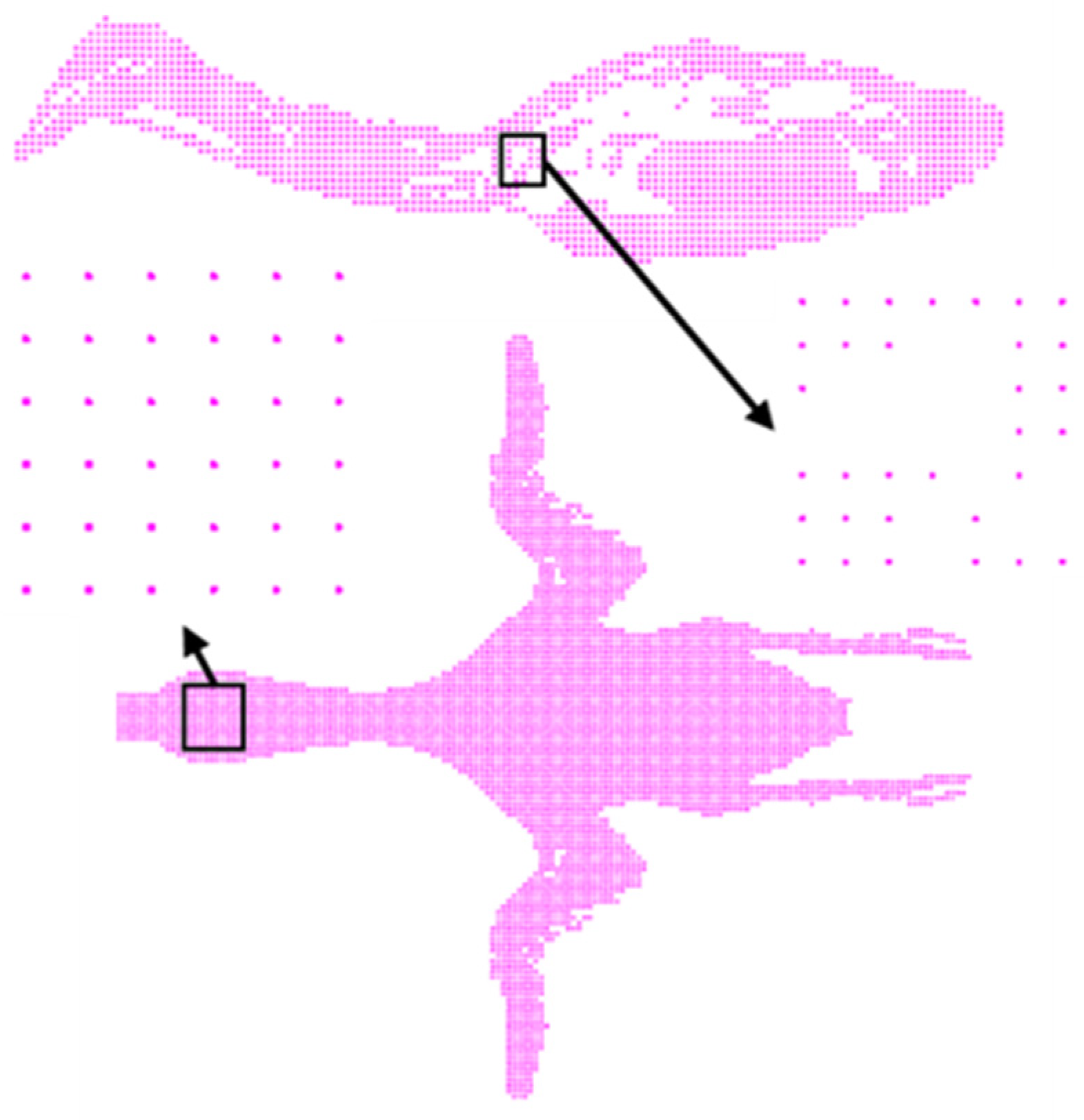
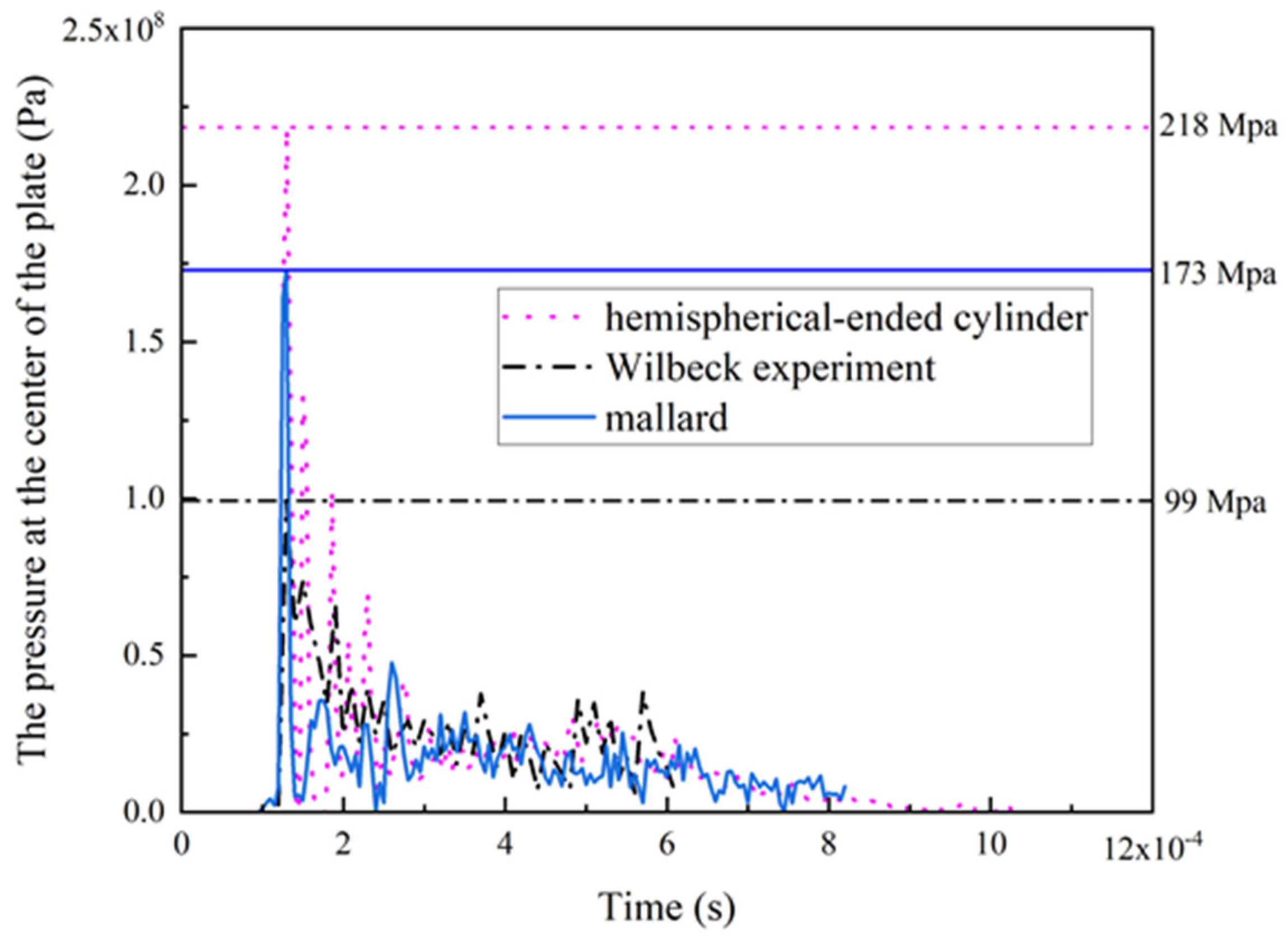

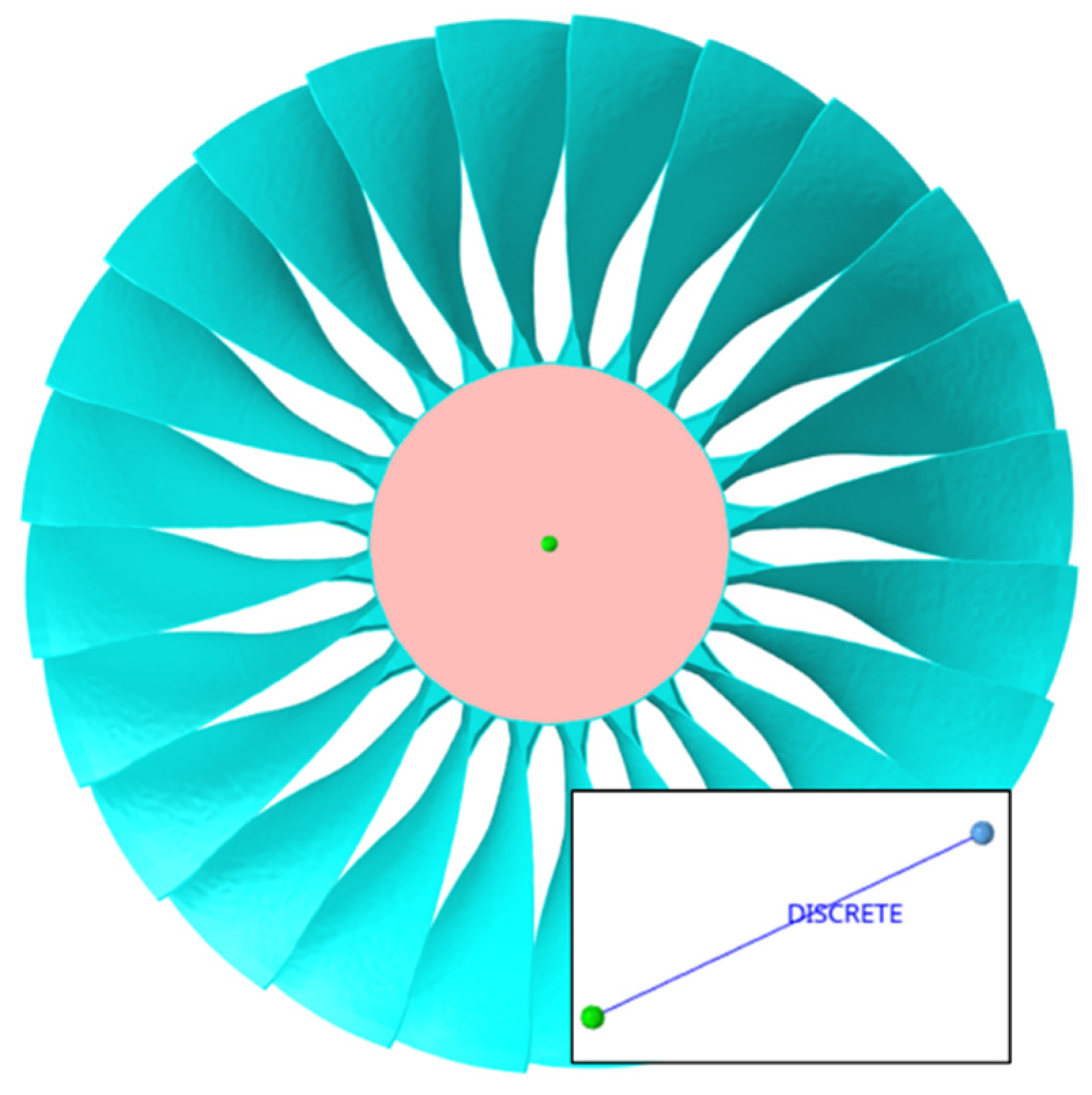


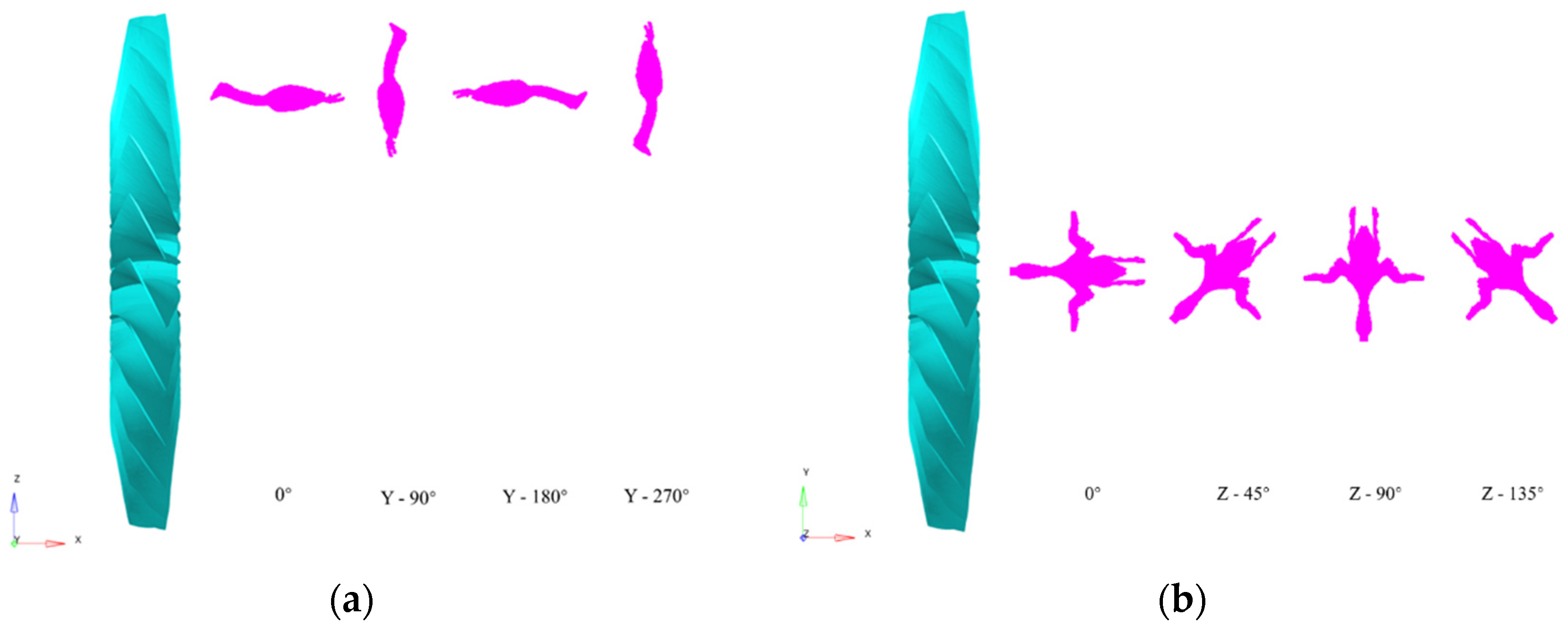
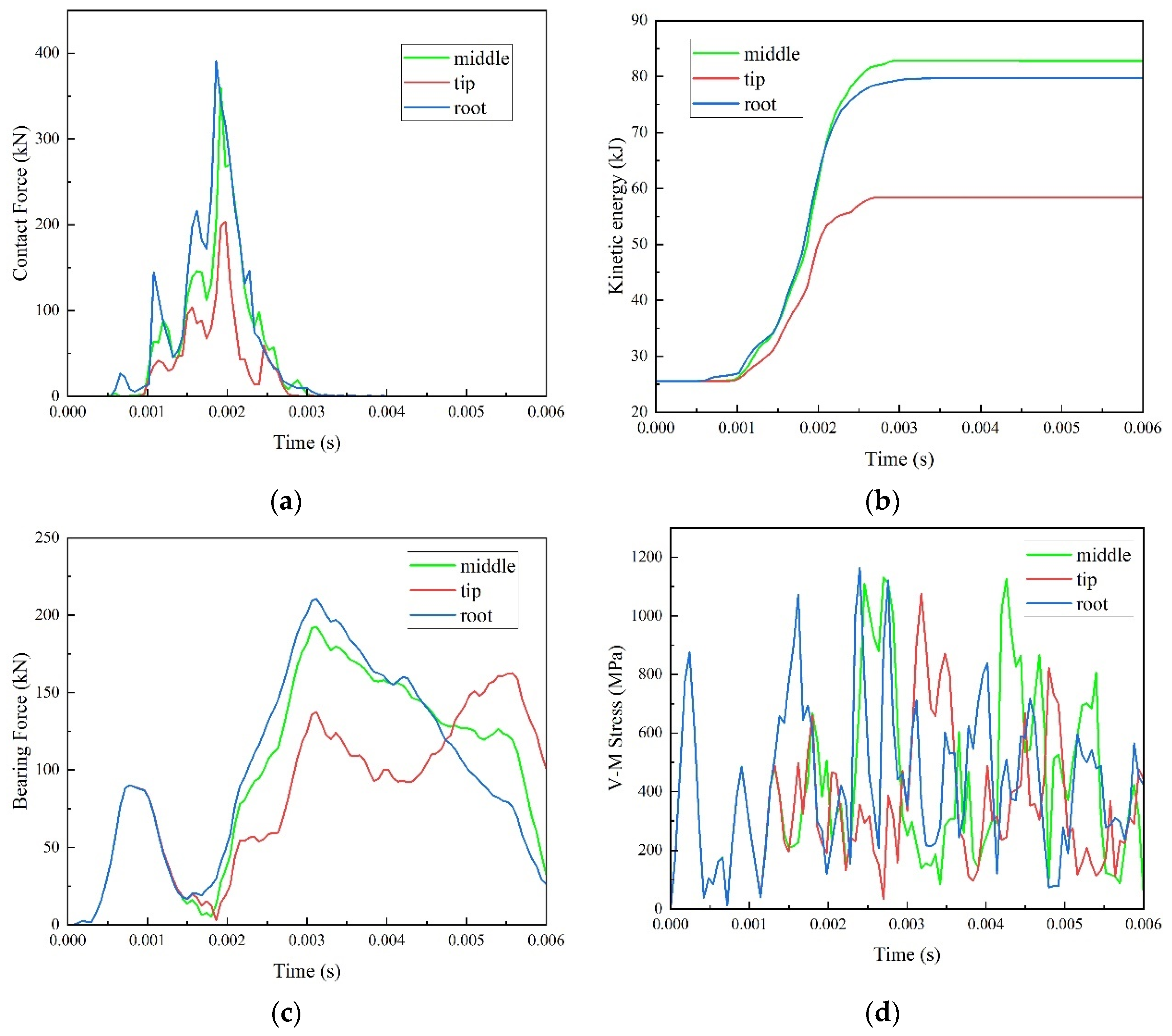

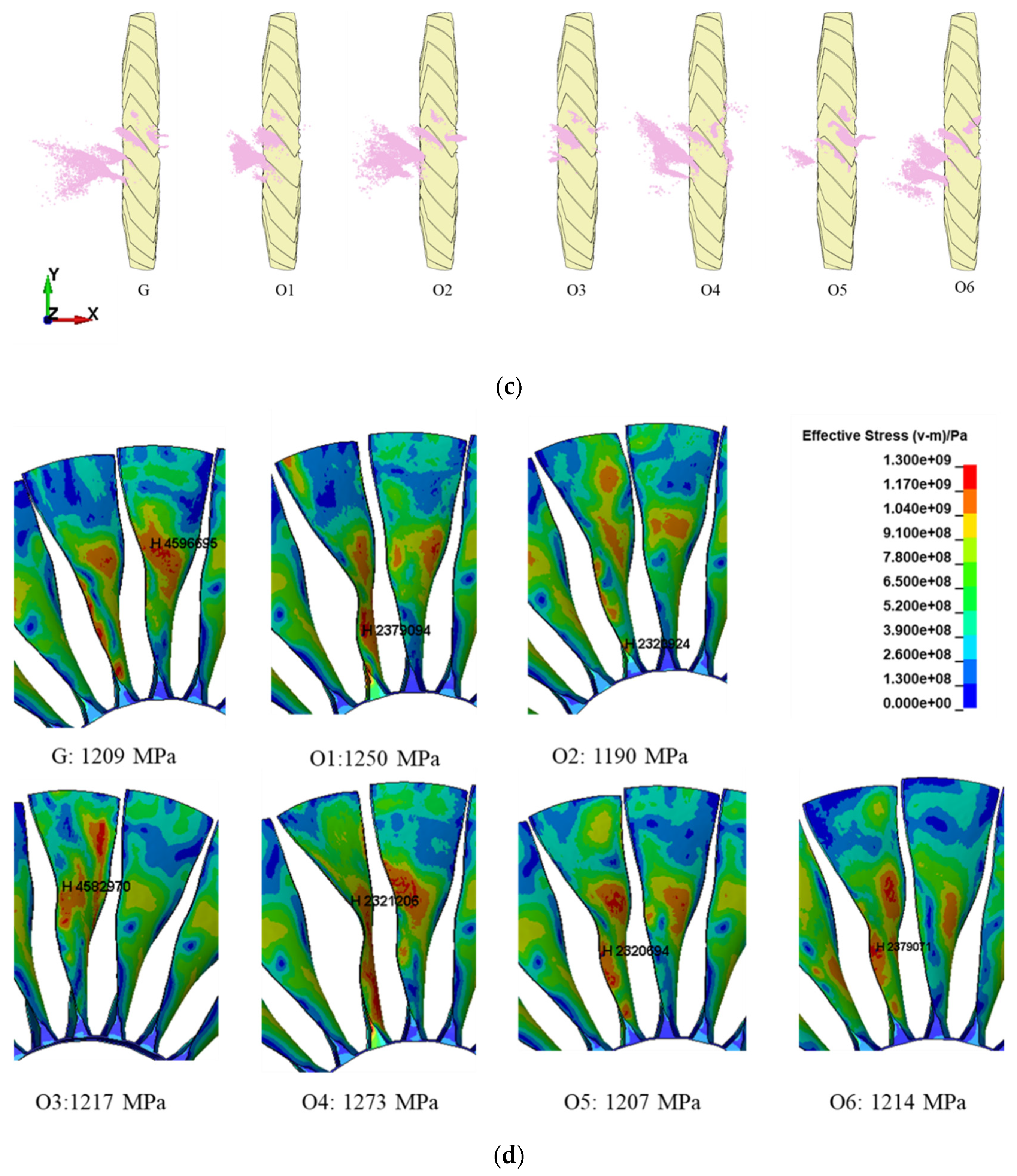
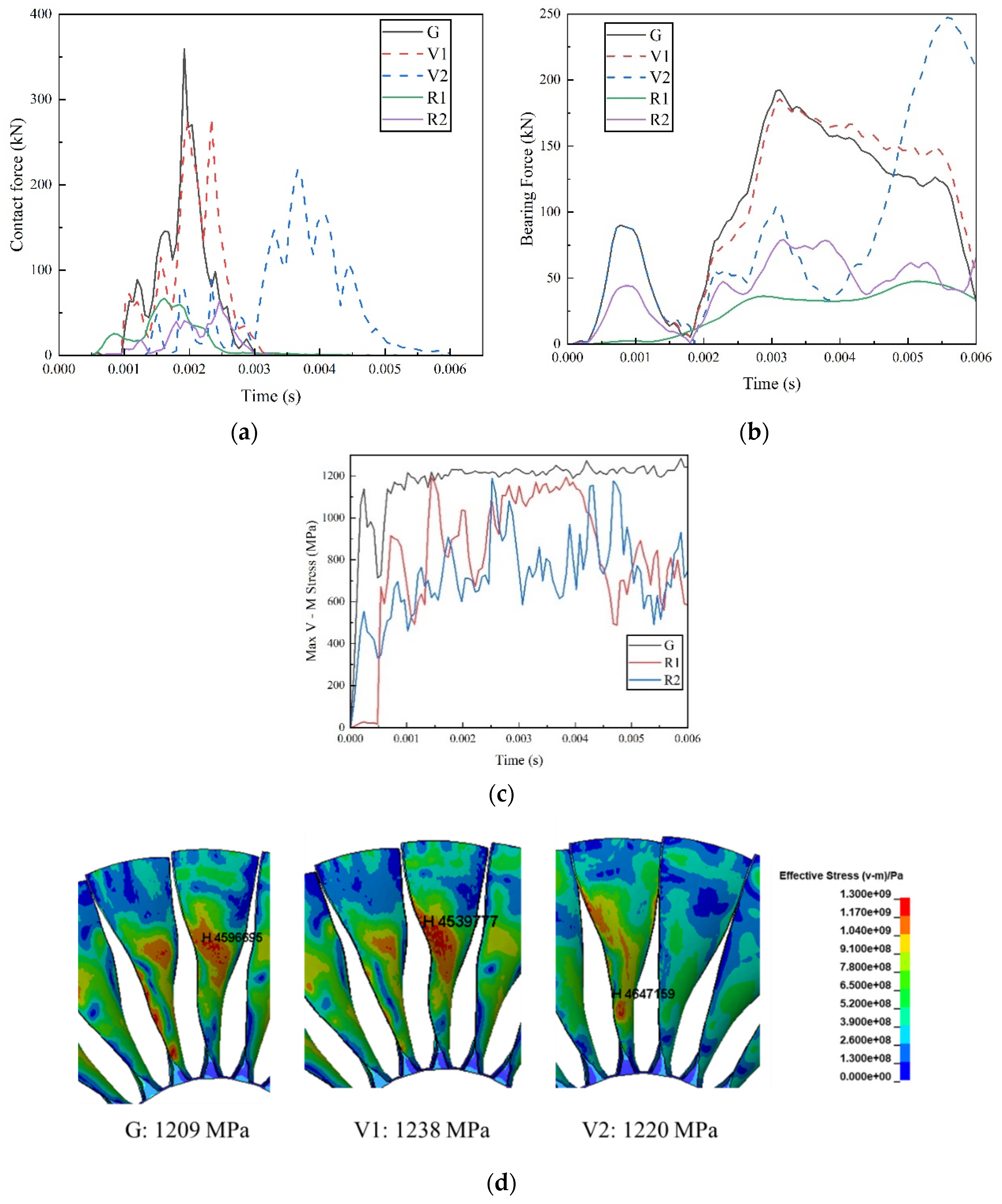
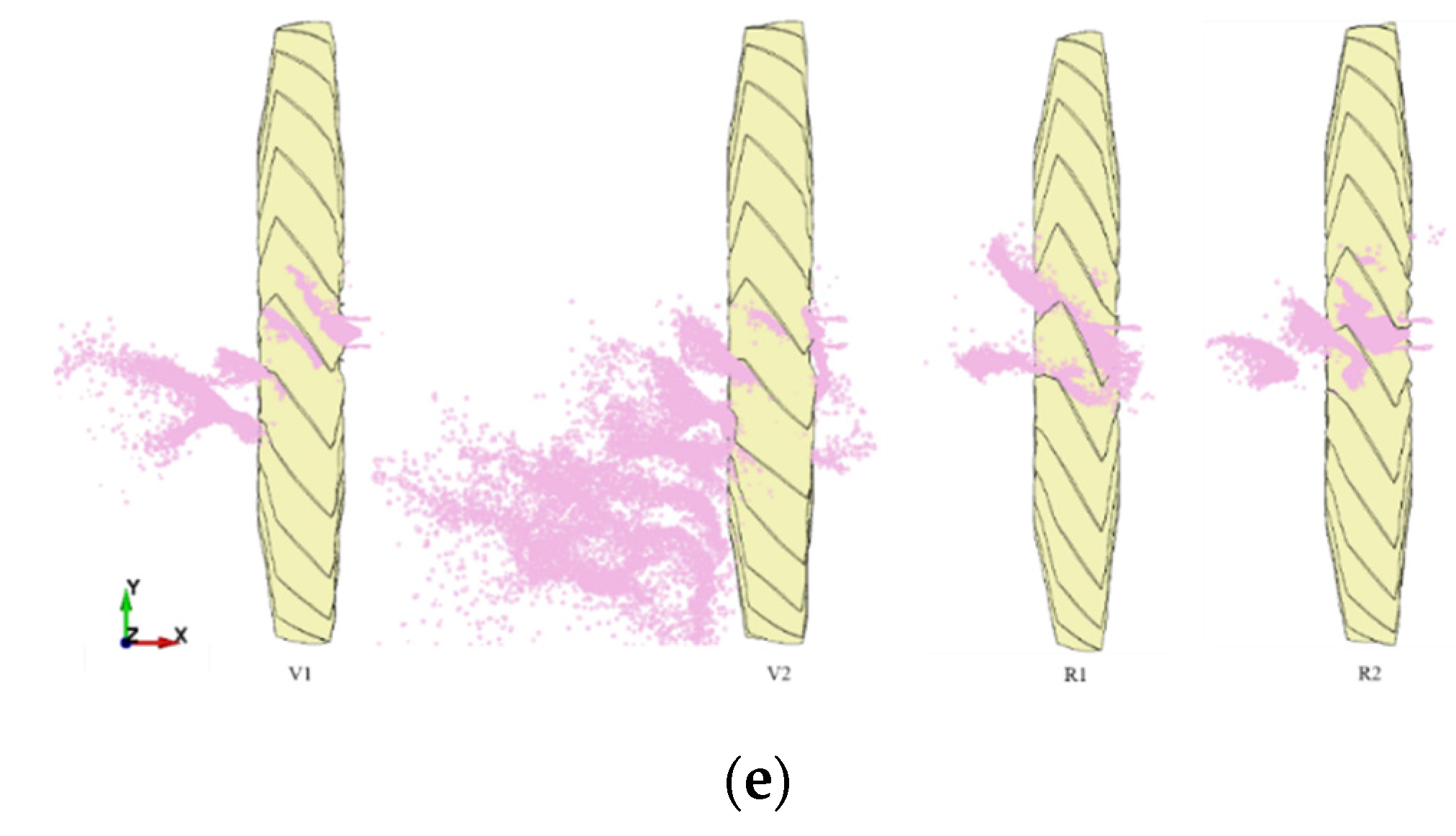

| Parameter | Value |
|---|---|
| Density | |
| Relative volumetric strain for erosion in tension | 1 |
| Relative volumetric strain for erosion in compression | 0.8 |
| Parameter | Value |
|---|---|
| C | 1480 m/s |
| S1 | 1.92 |
| S2 | 0 |
| S3 | 0 |
| 0.1 | |
| a | 0 |
| Parameter | Symbol | Value |
|---|---|---|
| Density | ||
| Shear modulus | 41.9 GPa | |
| Yield stress | 1098 MPa | |
| Strain hardening modulus | 1092 MPa | |
| Strain hardening exponent | 0.93 | |
| Strain rate dependence coefficient | 0.014 | |
| Softening exponent | 1.1 | |
| Melting temperature | 1878 K | |
| Room temperature | 293 K | |
| Specific heat | 612 J/kg·K | |
| Failure parameters | 0.112 | |
| 0.123 | ||
| 0.48 | ||
| 0.014 | ||
| 3.87 |
| Parameter | Value |
|---|---|
| 5130 m/s | |
| 1.028 | |
| 0 | |
| 0 | |
| 1.23 | |
| 0.17 |
| Case | Impact Location | Impact Orientation | Bird Initial Velocity (m/s) | Rotational Speed of the Engine (rad/s) | Support Stiffness (N/m) | Support Damping (Ns/m) |
|---|---|---|---|---|---|---|
| G | Middle | 0° | 253 | 600 | 500 | |
| L1 | Root | 0° | 253 | 600 | 500 | |
| L2 | Tip | 0° | 253 | 600 | 500 | |
| O1 | Middle | Y-90° | 253 | 600 | 500 | |
| O2 | Middle | Y-180° | 253 | 600 | 500 | |
| O3 | Middle | Y-270° | 253 | 600 | 500 | |
| O4 | Middle | Z-45° | 253 | 600 | 500 | |
| O5 | Middle | Z-90° | 253 | 600 | 500 | |
| O6 | Middle | Z-135° | 253 | 600 | 500 | |
| V1 | Middle | 0° | 225 | 600 | 500 | |
| V2 | Middle | 0° | 116 | 600 | 500 | |
| R1 | Middle | 0° | 253 | 88 | 500 | |
| R2 | Middle | 0° | 253 | 395 | 500 | |
| S1 | Middle | 0° | 253 | 600 | 500 | |
| S2 | Middle | 0° | 253 | 600 | 500 | |
| D1 | Middle | 0° | 253 | 600 | 5000 | |
| D2 | Middle | 0° | 253 | 600 | 10,000 |
| Case | G | O1 | O2 | O3 | O4 | O5 | O6 |
|---|---|---|---|---|---|---|---|
| Initial bird kinetic energy (kJ) | 25.59 | 25.59 | 25.59 | 25.59 | 25.59 | 25.59 | 25.59 |
| End bird kinetic energy (kJ) | 82.75 | 82.71 | 75.53 | 76.12 | 90.32 | 83.79 | 83.22 |
| Kinetic energy gain (kJ) | 57.16 | 57.12 | 49.94 | 50.53 | 64.73 | 58.20 | 57.63 |
| Case | G | V1 | V2 | R1 | R2 |
|---|---|---|---|---|---|
| Initial bird kinetic energy (kJ) | 25.59 | 20.25 | 5.38 | 25.59 | 25.59 |
| End bird kinetic energy (kJ) | 82.75 | 80.37 | 74.46 | 20.30 | 34.34 |
| Kinetic energy gain (kJ) | 57.16 | 60.12 | 69.08 | −5.29 | 8.75 |
| Case | G | S1 | S2 | D1 | D2 |
|---|---|---|---|---|---|
| Initial bird kinetic energy (kJ) | 25.59 | 25.59 | 25.59 | 25.59 | 25.59 |
| End bird kinetic energy (kJ) | 82.75 | 82.92 | 82.99 | 82.90 | 82.91 |
| Kinetic energy gain (kJ) | 57.16 | 57.33 | 57.40 | 57.31 | 57.32 |
Publisher’s Note: MDPI stays neutral with regard to jurisdictional claims in published maps and institutional affiliations. |
© 2021 by the authors. Licensee MDPI, Basel, Switzerland. This article is an open access article distributed under the terms and conditions of the Creative Commons Attribution (CC BY) license (https://creativecommons.org/licenses/by/4.0/).
Share and Cite
Wu, B.; Hedayati, R.; Li, Z.; Aghajanpour, M.; Zhang, G.; Zhang, J.; Lin, J. Effect of Impact and Bearing Parameters on Bird Strike with Aero-Engine Fan Blades. Appl. Sci. 2022, 12, 7. https://doi.org/10.3390/app12010007
Wu B, Hedayati R, Li Z, Aghajanpour M, Zhang G, Zhang J, Lin J. Effect of Impact and Bearing Parameters on Bird Strike with Aero-Engine Fan Blades. Applied Sciences. 2022; 12(1):7. https://doi.org/10.3390/app12010007
Chicago/Turabian StyleWu, Bin, Reza Hedayati, Zhehua Li, Mahsa Aghajanpour, Guichang Zhang, Junhong Zhang, and Jiewei Lin. 2022. "Effect of Impact and Bearing Parameters on Bird Strike with Aero-Engine Fan Blades" Applied Sciences 12, no. 1: 7. https://doi.org/10.3390/app12010007
APA StyleWu, B., Hedayati, R., Li, Z., Aghajanpour, M., Zhang, G., Zhang, J., & Lin, J. (2022). Effect of Impact and Bearing Parameters on Bird Strike with Aero-Engine Fan Blades. Applied Sciences, 12(1), 7. https://doi.org/10.3390/app12010007







